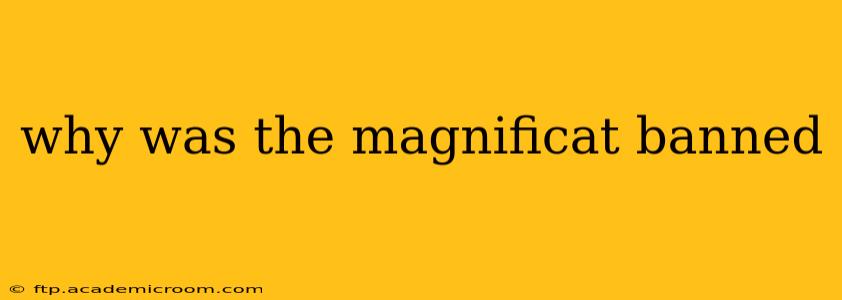The Magnificat, the canticle of Mary found in Luke 1:46-55, is a cornerstone of Christian liturgy. The idea that it was ever banned is a simplification, and the reality is far more nuanced. There's no single, universal "ban" on the Magnificat throughout history, but rather instances of its restricted use or altered interpretation within specific contexts. Let's explore the complexities surrounding this claim.
Was the Magnificat ever officially banned by the Catholic Church?
No, the Magnificat was never officially banned by the Catholic Church as a whole. The Church has always held the Magnificat in high regard, recognizing its theological significance and liturgical importance. The idea of a widespread ban is inaccurate. However, there have been instances where its use was restricted or altered, depending on the historical and theological climate.
Why were some interpretations or uses of the Magnificat questioned or restricted?
Certain interpretations or contextual uses of the Magnificat have faced scrutiny throughout history. These challenges stem primarily from:
1. Political and Social Interpretations:
During times of political or social upheaval, certain interpretations of the Magnificat's themes of social justice and overthrow of the powerful could be seen as subversive by those in authority. The Magnificat's powerful message of empowerment for the marginalized and its critique of the powerful could be interpreted as inciting rebellion or challenging established hierarchies. This doesn't equate to a ban on the text itself, but rather a cautionary approach to its public proclamation in specific socio-political contexts.
2. Theological Interpretations:
Different theological schools of thought may emphasize certain aspects of the Magnificat while downplaying others. These varied interpretations, while not amounting to a ban, could lead to different liturgical usages or textual emphases depending on the dominant theological climate. For instance, during periods emphasizing humility and submission, certain aspects of the Magnificat's revolutionary message might be toned down.
3. Liturgical Reform:
Liturgical reforms, like those associated with the Second Vatican Council, have affected the frequency and context in which the Magnificat is sung. While not a "ban," changes in the liturgy naturally lead to shifts in how and when specific texts, including the Magnificat, are used. This is a matter of liturgical evolution rather than suppression.
What are some alternative interpretations of the Magnificat's role in history?
The Magnificat's enduring popularity and consistent presence in Christian worship attest to its central place in the faith. It's more accurate to talk about fluctuating interpretations and applications rather than a complete ban. The text's adaptability and powerful message have allowed it to resonate across diverse historical periods and contexts, even when its use was subtly influenced by prevailing socio-political or theological currents.
Conclusion
The assertion of a "ban" on the Magnificat is misleading. While its use and interpretation have been subject to contextual shifts and varied emphases throughout history, the text itself remains a powerful and central element of Christian tradition. Understanding the historical complexities surrounding its use requires looking beyond simplistic narratives of suppression to explore the nuances of evolving theological interpretations and their interaction with the socio-political landscape.
